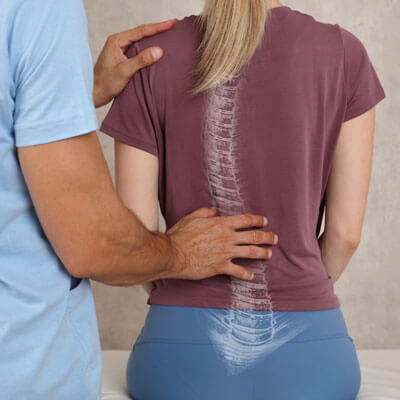Scoliosis in Frisco
 Considered an abnormal sideways curvature of the spine, scoliosis begins as a postural distortion. If scoliosis is left untreated it could become a permanent deformity.
Considered an abnormal sideways curvature of the spine, scoliosis begins as a postural distortion. If scoliosis is left untreated it could become a permanent deformity.
There are three causes of scoliosis:
- congenital (genetic predisposition)
- habitual (behavioral routines)
- idiopathic (unknown cause)
Are There Obvious Clues?
A parent may notice that their child has a high shoulder or low hip that makes clothing fit poorly. Uneven shoe wear also may provide a clue. Children with scoliosis also may experience back and leg pains but these are usually dismissed as “growing pains.”
Wait and See?
Scoliosis may often worsen if left to just “run its course.” In severe cases a child may need to wear an unsightly or cumbersome brace or have surgery that attaches steel rods, forcing the spine to straighten.
Natural Approach
Chiropractic adjustments may help to improve the spine’s structure and function. Because an adjustment also may help strengthen and retrain muscles, your child’s posture may improve.
If you think your child may have scoliosis we recommend that you bring them in so we can provide an evaluation and determine if we think we can help.
Frequently Asked Questions
Isn’t a certain amount of sideways curvature considered normal?
When does scoliosis require care?
Do heavy backpacks cause scoliosis?
What types of techniques do you find successful for treating scoliosis?
How long until patients typically notice relief?
What is the process like? We very carefully evaluate the spine so that we only address and work on the spinal joints that are unhealthy while leaving the healthy joints alone. This is critical! This is what will help to create strength and stability in their spine instead of just creating a feeling of looseness throughout their spine.
Do you welcome children and adults for scoliosis care?
Besides chiropractic, what other treatments do you use for scoliosis?
Tell Me a Patient Success Story
Background: Emily, a 16-year-old high school student, was diagnosed with mild scoliosis. She experienced frequent back pain and discomfort, which interfered with her daily activities and passion for dance.
Initial Consultation: During her first visit to Venn Chiropractic, Emily’s spine curvature was carefully assessed. We noted a moderate C-shaped curve in her thoracic spine, contributing to her discomfort and limited mobility.
Chiropractic Treatment Plan: We developed a personalized treatment plan for Emily, which included:
- Spinal Adjustments: Gentle, specific adjustments were applied to correct misalignments and reduce the pressure on her nerves.
- Posture Correction Exercises: Targeted exercises to strengthen her back muscles and improve posture were introduced.
- Flexibility Training: This included stretches to increase spinal mobility and reduce muscle tension.
- Regular Monitoring: Emily’s spinal curvature was regularly monitored to track progress and make necessary adjustments to her treatment plan.
Progress and Outcome: After several weeks of consistent chiropractic care and adherence to her exercise regimen, Emily reported a significant reduction in back pain. Her posture improved noticeably, which also enhanced her performance in dance.
Long-term Results: Over several months, with ongoing chiropractic care, Emily’s spinal curvature showed signs of improvement. She experienced less discomfort, greater mobility, and an enhanced quality of life. Her dance technique also benefited from her improved posture and reduced pain.
Conclusion: Emily’s journey demonstrates the potential of chiropractic care in managing scoliosis-related symptoms. With regular treatments, specific exercises, and lifestyle adjustments, chiropractic care helped Emily not only reduce her discomfort but also enabled her to continue pursuing her passion for dance without the hindrance of scoliosis pain.

